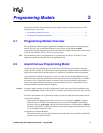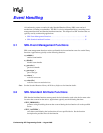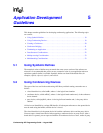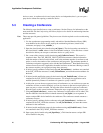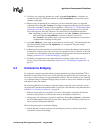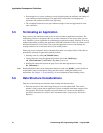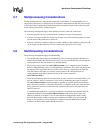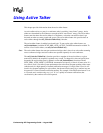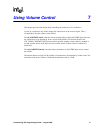
Conferencing API Programming Guide — August 2006 21
Application Development Guidelines
11. If desired, you can specify attributes for a party using cnf_SetAttributes( ). Attributes are
contained in the CNF_ATTR data structure. Use cnf_GetAttributes( ) to return the current
attributes for the party.
12. Before a party can participate in a conference, you must connect this party to a supported
technology device using dev_Connect( ). Examples of supported technology devices include a
voice device (dxxxB1C1) and an IP device (ipmB1C1). See Section 1.3, “Understanding How
Conferences are Formed”, on page 10 for details on supported technology devices. See the
Device Management API Library Reference for details on device management functions.
Note: Depending on your use case, you can choose to issue dev_Connect( ) either before or
after performing the cnf_AddParty( ) operation in Step 13. If you issue
dev_Connect( ) after adding a party, you must wait for this function to successfully
complete before streaming can take place.
13. Using cnf_AddParty( ), add a party to the conference created in step 7. This function takes the
party device handle returned by cnf_OpenParty( ) as an argument. The party created
consumes a party resource.
14. Add more parties to the conference as needed. There is a limit to the number of parties that can
be added to a conference (the count of resources was obtained in step 3). However, if the limit
is reached, you can add parties using the conference bridging feature. For more information on
bridging, see Section 5.4, “Conference Bridging”, on page 21.
15. Terminate your application in an orderly fashion. For example, disable events, close all
devices, and so on. For more information, see Section 5.5, “Terminating an Application”, on
page 22.
5.4 Conference Bridging
If a conference expands beyond the number of parties permitted by the Intel NetStructure
®
Host
Media Processing software license in use and, if applicable, the media load in use on the board, you
can create a second conference to support additional conferees. The two conferences are connected
via a conference bridge. Conference bridging allows all parties in two or more conferences to speak
with and/or listen to one another.
The following guidelines for creating a conference bridge assume that you have already created
two conferences and added the desired number of parties for each conference using the instructions
in Section 5.3, “Creating a Conference”, on page 20.
• Dedicate a party (party1) in conference A to serve as the bridge to conference B. Likewise,
dedicate a party (party2) in conference B to serve as the bridge to conference A.
• Connect party1 in conference A to party2 in conference B using dev_Connect( ), a function in
the Device Management API library. See the Device Management API Library Reference for
details on device management functions.
The following rules apply to conference bridging:
• Each bridge that is created consumes two licensed party resources, one from each of the
conferences involved in the bridge.



